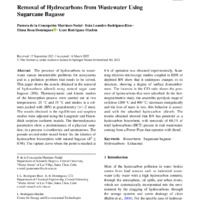Removal of Hydrocarbons from Wastewater Using Sugarcane Bagasse
Item
-
Tipo do ITEM
-
Artigo Ciêntifico
-
Título do Artigo
-
Removal of Hydrocarbons from Wastewater Using Sugarcane Bagasse
-
Descrição
-
The presence of hydrocarbons in wastewater causes innumerable problems for ecosystems
and is a pollution problem that needs to be solved. This paper shows the results obtained in the removal of hydrocarbons (diesel) using natural sugar cane bagasse (BN). Thermodynamic and kinetic studies of the biosorption process were carried out at two temperatures: 25 °C and 35 °C and studies in a column packed with (BN) at granulometry (+1–2 mm). The results obtained in the equilibrium and sorption studies were adjusted using the Langmuir and Freundlich sorption isotherm models. The thermodynamic parameters show a predominance of a physical sorption; in a process is exothermic and spontaneous. The pseudo second-order model better fts the kinetics of hydrocarbon biosorption with natural bagasse (R2 ≥ 0.98). The rupture curve where the point is reached 6 h of operation was obtained experimentally. Scanning electron microscopy studies coupled to EDX of depleted BN show that it undergoes changes in its structure, showing a degree of surface dismemberment. The increase in the C/O ratio shows the presence of hydrocarbons that were adsorbed. In the thermogravimetric study, the anaerobic pyrolysis stage of cellulose (200 °C and 400 °C) decreases energetically and the loss of mass is less; this behavior is associated with the adsorbed hydrocarbon (diesel). The results obtained showed that BN has potential as a hydrocarbon biosorbent, with removals of 60.3% of total hydrocarbons (HCT) present in real wastewater, coming from a Power Plant that operates with diesel .
-
Abstract
-
The presence of hydrocarbons in wastewater causes innumerable problems for ecosystems
and is a pollution problem that needs to be solved. This paper shows the results obtained in the removal of hydrocarbons (diesel) using natural sugar cane bagasse (BN). Thermodynamic and kinetic studies of the biosorption process were carried out at two temperatures: 25 °C and 35 °C and studies in a column packed with (BN) at granulometry (+1–2 mm). The results obtained in the equilibrium and sorption studies were adjusted using the Langmuir and Freundlich sorption isotherm models. The thermodynamic parameters show a predominance of a physical sorption; in a process is exothermic and spontaneous. The pseudo second-order model better fts the kinetics of hydrocarbon biosorption with natural bagasse (R2 ≥ 0.98). The rupture curve where the point is reached 6 h of operation was obtained experimentally. Scanning electron microscopy studies coupled to EDX of depleted BN show that it undergoes changes in its structure, showing a degree of surface dismemberment. The increase in the C/O ratio shows the presence of hydrocarbons that were adsorbed. In the thermogravimetric study, the anaerobic pyrolysis stage of cellulose (200 °C and 400 °C) decreases energetically and the loss of mass is less; this behavior is associated with the adsorbed hydrocarbon (diesel). The results obtained showed that BN has potential as a hydrocarbon biosorbent, with removals of 60.3% of total hydrocarbons (HCT) present in real wastewater, coming from a Power Plant that operates with diesel .
-
Língua do arquivo
-
inglês
-
Data da Publicação
-
Ano 2022
-
Palavra-chave
-
Biosorbents
-
Sugarcane bagasse
-
Hydrocarbons
-
Exhausted
-
Autores
-
Pastora de la Concepción Martínez‑Nodal
-
· Iván Leandro Rodríguez‑Rico
-
Elena Rosa Domínguez
-
Lizet Rodríguez‑Machín
-
Local
-
ITEGAM - CUBA, 2022


